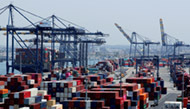inaction may put
cities under water.
By JUSTIN GILLIS
TASIILAQ, Greenland AT GREAT RISK and with diminished support, scientists are racing to answer one of the most urgent - and most widely debated - questions facing humanity: How fast is the world’s ice going to melt? Scientists long believed that the collapse of the gigantic ice sheets in Greenland and Antarctica would take thousands of years, with sea level possibly rising as little as 18 centimeters in this century, about the same amount as in the 20th century.
Below, measuring ice is dangerous work. Fiammetta Straneo hangs off the side of a helicopter over Greenland to take a reading.
But researchers have recently been startled to see big changes unfold in both Greenland and Antarctica. As a result of recent calculations that take the changes into account, many scientists now say that sea level is likely to rise perhaps one meter by 2100 ? an increase that would pose a threat to coastal regions the world over.
And the calculations suggest that the rise could conceivably exceed 1.8 meters, which would put thousands of hectares of the American coastline under water and would probably displace tens of millions of people in Asia. The scientists say that a rise of even one meter would inundate low-lying lands in many countries, rendering some areas uninhabitable.
It would cause coastal flooding of the sort that now happens once or twice a century to occur every few years. It would cause much faster erosion of beaches, barrier islands and marshes. It would contaminate fresh water supplies with salt. Some of the world’s great cities ? London, Cairo, Bangkok, Venice and Shanghai among them ? would be critically endangered .
In the United States, parts of the East Coast and Gulf Coast would be hit hard. In New York, coastal flooding could become routine. Climate scientists readily admit that the one-meter estimate could be wrong. Their understanding of the changes is still primitive. But, they say, it could just as easily be an underestimate. “I think we need immediately to begin thinking about our coastal cities ? how are we going to protect them?” said John A.
Church, an Australian scientist who is a leading expert on sea level. “We can’t afford to protect everything. We will have to abandon some areas.” Sea-level rise has been a particularly contentious element in the global warming debate. One estimate suggested the threat was so dire that sea level could rise as much as 4.6 meters in this century.
Global warming skeptics contend that any changes occurring in the ice sheets are probably due to natural climate variability, not to greenhouse gases released by humans. A large majority of climate scientists argue that heat-trapping gases are almost certainly playing a role .
They add that the lack of policies to limit emissions is raising the risk that the ice will go into an irreversible declinebefore this century is out, a development that would eventually make a one-meter rise in the sea look trivial.
Besides the melting ice is by no means the only sign that the earth is warming, thermometers on land, in the sea and aboard satellites show warming. Heat waves, flash floods and other extreme weather events are increasing. Plants are blooming earlier, coral reefs are dying and many other changes are attributed to global warming by scientists.
Yet, while the rise of the sea could turn out to be the single most serious effect of global warming, no wealthy country has made understanding the changes in the ice a strategic national priority. The consequence is that researchers lack elementary information, and the missing information makes it impossible for scientists to be sure how serious the situation is. “The things I’ve seen in Greenland in the last five years are alarming,” said Gordon Hamilton, of the University of Maine.
“We see these ice sheets changing literally overnight.” Dodging Icebergs On a late summer day in southeastern Greenland, a helicopter pilot, Morgan Goransson, dropped low toward the water. Hanging out of the side of the aircraft, scientists sent a measuring device between the ice floes.
The frigid waters of Sermilik Fjord were only nine meters below, so any mechanical problem would have sent the chopper plunging into the sea. “It is so dangerous,” Mr. Goransson said. Taking the temperature of waters near the ice sheet is essential to understanding what is happening in Greenland.
But it is complex and risky. The scientists ? Fiammetta Straneo, of the Woods Hole Oceanographic Institution in Massachusetts, and Dr. Hamilton ? are part of a team that is financed by the National Science Foundation . A few weeks ago, they obtained a reading of 4 degrees Celsius near the bottom of the fjord, the highest they had seen there.
The reading fit a broader pattern . Warmer water that originated far to the south is flushing into Greenland’s fjords. Scientists suspect that as it melts the ice from beneath, the water is loosening the connection of the glaciers to the ground . This allows the glaciers to move faster and dump more ice into the ocean.
The overall loss of ice seems to be accelerating, an ominous sign given that the island contains enough ice to raise global sea levels by more than six meters. Strictly speaking, scientists have not proved that human-induced global warming is the cause of the changes.
They are mindful that the climate in the Arctic undergoes big natural variations. Yet scientists say that the recent changes in Greenland are occurring at the same time that air and ocean temperatures are warming, and ice melt is accelerating, in much of the world. Helheim Glacier, which terminates in Sermilik Fjord, is one of a group of glaciers in southeastern Greenland that have shown especially big changes.
S omething caused the glacier, one of Greenland’s largest, to speed up sharply in the middle of the last decade, and it spit so much ice into the ocean that it thinned by some 91 meters in a few years. The glacier has behaved erratically ever since, and that pattern is being repeated all over Greenland. A Rising Ocean To a majority of climate scientists, the question is not whether the earth’s land ice will melt, but whether it will happen too fast for society to adjust.
Recent research suggests that the volume of the ocean may have been stable for thousands of years. But it began to rise in the 19th century, around the same time that advanced countries began to burn large amounts of coal and oil. The sea has risen about 20 centimeters since then, on average. Such an increase is enough to cause substantial erosion.
In its last big report, in 2007, the United Nations group that assesses climate science, the Intergovernmental Panel on Climate Change, said that sea level would rise at least 18 more centimeters, and might rise as much as 61 centimeters, in the 21st century.
But the group warned that these estimates did not fully incorporate the possibility that the world’s big ice sheets would start spitting ice into the ocean at a much faster rate than it could melt on land. Scientific understanding of this prospect was so poor, the climate panel said, that no meaningful upper limit could be put on the potential rise of sea level.
Satellite evidence suggests that the rise of the sea accelerated late in the 20th century, so that the level is now increasing a little over 2.5 centimeters per decade, on average . Increased melting of land ice appears to be a major factor. Ano
ther is that most of the extra heat being trapped by human greenhouse emissions is warming the ocean, not the atmosphere, and as it warms, the water expands.
A developing consensus among climate scientists puts the best estimate of the pace of the rising sea at a little over one meter between now and 2100. Calculations suggest that that would cause shoreline erosion to accelerate markedly. In places that once flooded only in a large hurricane, a routine storm could have the same result.
The worst effects would probably occur in areas where land is sinking even as the sea rises. That applies to some of the world’s major cities. Defenses can be built to keep out the sea, of course, like the levees of New Orleans and the dikes of the Netherlands. But the expense is likely to soar as the ocean rises .
Storm surges battering the world’s coastlines every few years would almost certainly force people to flee inland. But it is hard to see where the displaced would go, especially in Asia, where huge cities ? and even countries, like Bangladesh ? are at risk.
And, scientists say, if their projections prove accurate, the sea will not stop rising in 2100. By that point, the ice sheets could be undergoing extensive melting. “Beyond a hundred years out, it starts to look really challenging,” said Richard B. Alley, a climate scientist at Pennsylvania State University.
“You start thinking about every coastal city on the planet hiding behind a wall, with storms coming.” No Plan, No Information Because no advanced country has made a priority of studying land ice, scientists lack elementary information that they need to make sense of what is happening.
They do not know the lay of the land beneath most of the world’s glaciers well enough to calculate how fast the ice might retreat. They have only haphazard readings of the depth and temperature of the ocean near Greenland, needed to figure out why so much warm water seems to be attacking the ice sheet. The information problems are even more severe in Antarctica.
Figuring out whether Antarctica is losing ice over all is essential, because that ice sheet contains enough water to raise global sea level by nearly 61 meters. Daniel Schrag, a geochemist and head of Harvard University’s Center for the Environment, praised the scientists who do difficult work studying ice, but added, “The scale of what they can do, given the resources available, is just completely out of whack with what is required.
” Climate scientists worry that extensive melting of land ice may become inevitable before political leaders find a way to limit heat-trapping gases, and before scientists even realize such a point of no return has been passed.
“The past clearly shows that sealevel rise is getting faster and faster the warmer it gets,” Dr. Rahmstorf said. “Why should that process stop? If it gets warmer, ice will melt faster.”
스마터리빙
more [ 건강]
[ 건강]이제 혈관 건강도 챙기자!
[현대해운]우리 눈에 보이지 않기 때문에 혈관 건강을 챙기는 것은 결코 쉽지 않은데요. 여러분은 혈관 건강을 유지하기 위해 어떤 노력을 하시나요?
 [ 건강]
[ 건강]내 몸이 건강해지는 과일궁합
 [ 라이프]
[ 라이프]벌레야 물럿거라! 천연 해충제 만들기
 [ 건강]
[ 건강]혈압 낮추는데 좋은 식품
[현대해운]혈관 건강은 주로 노화가 진행되면서 지켜야 할 문제라고 인식되어 왔습니다. 최근 생활 패턴과 식생활의 변화로 혈관의 노화 진행이 빨라지고
사람·사람들
more많이 본 기사
- [‘로드 레이지’ 한인 피살 현장 상세 상황] 끼어들기 시비가 비극으로… 차에서 내려 “쏴봐라” 언쟁
- [이민 단속] 여권 소지 시민권자들 … 1
- 크리스마스 대형 폭풍… 침수·산사태 대비 ‘비상’
- 가난해서 흙 팠는데… ‘다이아’ 캤다
- [성탄절 문 여는 곳은] 코스코·월마트 닫고… CVS는 영업
- [이민 단속] 새해에도 더 공격적 단속
- 취업비자(H-1B), 고연봉자 우선 발급
- 연방대법, 시카고 주방위군 투입 ‘기각’
- MC몽, 차가원 회장 충격 불륜 부인.. “채무 120억 당연히 이행”
- 두 손 모아 성탄기도… “온 세상에 평화를”
- ‘마약 혐의’ 남양유업 창업주 외손녀 황하나 경찰에 체포
- 불체자 자진출국하면 지원금 3배로 ‘3천불’
- ICE 홈디포 급습 한인 체포
- 해외서도 극과극 반응’대홍수’, 넷플릭스 글로벌 1위 차지”SF 걸작 vs 최악”
- ‘파워볼’ 열풍 계속… 오늘 잭팟상금 17억 달러
- 차기 대선 선호도… 공화 ‘밴스’ ·민주 ‘뉴섬’ 선두
- 트럼프 “마두로 물러나라” 최후통첩
- 정동원, 내년 2월 23일 해병대 입대..전역 예정일은 27년 8월 22일
- 엡스타인 자료 추가 공개… “전용기에 트럼프 8번 타”
- 송성문, 메디컬테스트에 초긴장 “혹시 뭐 나올까 걱정했다→미국 열심히 갔는데 맨손으로 돌아올까봐”
- 이하늬, 기획사 미등록 혐의 검찰 송치.. “10월 정식 등록”
- “ATM기 사용하기 겁나네”
- ‘트롯돌’ 손태진, 오디션 우승상금 7~8억?.. “무서워서 1년 넘게 안 썼다”
- ‘올해는 ICE 이민자 체포 광풍의 해’
- 4인 가족 보험료가 4만불까지… 중산층‘불안’
- MD 로우스 직원, 지게차로 70대 노인 살해
- [건강포커스] “모든 니코틴은 심혈관 독소…청소년 중독 방지 대책 시급”
- 양민혁·배준호 등 병역특례 기대감 커졌다, 日 자국 아시안게임도 ‘U-21’ 참가
- ‘평양무인기’ 김용현·여인형 추가 구속…법원 “증거인멸 염려”
- 올해 워싱턴DC 식당 92곳 폐업…‘역대 최다’
- “트럼프 정부, 망명신청자 8천명 과테말라 등 제3국 추방 추진”
- 잇단 트럼프 때리기에도…파월, 지지율 3부 요인중 최고
- 美, EU 전 집행위원 등 5명 입국금지… “미국 빅테크 표현 검열”
- “트럼프 행정부, 스페이스X에 동물보호구역 토지 양도 검토”
- 워너브러더스 주주 “파라마운트 인수안 여전히 불충분”
- 뚜레쥬르, 뉴욕 맨해튼에 직영 ‘매디슨 스퀘어 파크점’ 열어
- 온라인쇼핑과 반품, 그리고 그 이후 1
- 뉴저지한인고교생들, 양로원에 핸드 로션 기증
- ‘연방하원 도전장’ 척 박 예비후보 후원모임
- 美 경제 3분기 4.3% ‘깜짝 성장’…강한 소비가 성장견인
- 2명에 모두 7,500달러 장학금
- 한인 최초 NASA 우주비행사 조니 김 “우주서 김치·밥 그리웠다”
- [미국은 지금] MAGA의 분열, 예견된 균열의 시작
- ‘뉴욕한인의 밤’ 일반한인 참여 문턱 낮췄다
- “온 세상에 평화를⋯”
- 밀알·노숙자센터에 1,500달러씩 기부
- ‘계엄연루’ 추경호 첫재판…특검 “국민관심 커 신속재판해야”
- 미 해군 군함 명칭 전통 깬 ‘트럼프급 전함’
- 탁 트인 전망과 불꽃놀이로 즐기는 PALMS CASINO RESORT의 올인클루시브 2026 새해 맞이
- 박나래, 논란 또 추가..이번엔 ‘나혼산’ 조작 방송 의혹
1/5지식톡

-
 미 육군 사관학교 West Poin…
0
미 육군 사관학교 West Poin…
0https://youtu.be/SxD8cEhNV6Q연락처:wpkapca@gmail.comJohn Choi: 714-716-6414West Point 합격증을 받으셨나요?미 육군사관학교 West Point 학부모 모…
-
 ☝️해외에서도 가능한 한국어 선생님…
0
☝️해외에서도 가능한 한국어 선생님…
0이 영상 하나면 충분합니다!♥️상담신청문의♥️☝️ 문의 폭주로 '선착순 상담'만 진행합니다.☎️ : 02-6213-9094✨카카오톡ID : @GOODEDU77 (@골뱅이 꼭 붙여주셔야합니다…
-
 테슬라 자동차 시트커버 장착
0
테슬라 자동차 시트커버 장착
0테슬라 시트커버, 사놓고 아직 못 씌우셨죠?장착이 생각보다 쉽지 않습니다.20년 경력 전문가에게 맡기세요 — 깔끔하고 딱 맞게 장착해드립니다!장착비용:앞좌석: $40뒷좌석: $60앞·뒷좌석 …
-
 식당용 부탄가스
0
식당용 부탄가스
0식당용 부탄가스 홀세일 합니다 로스앤젤레스 다운타운 픽업 가능 안녕 하세요?강아지 & 고양이 모든 애완동물 / 반려동물 식품 & 모든 애완동물/반려동물 관련 제품들 전문적으로 홀세일/취급하는 회사 입니다 100% …
-
 ACSL 국제 컴퓨터 과학 대회, …
0
ACSL 국제 컴퓨터 과학 대회, …
0웹사이트 : www.eduspot.co.kr 카카오톡 상담하기 : https://pf.kakao.com/_BEQWxb블로그 : https://blog.naver.com/eduspotmain안녕하세요, 에듀스팟입니다…
케이타운 1번가
오피니언
 정숙희 논설위원
정숙희 논설위원온라인쇼핑과 반품, 그리고 그 이후
 파리드 자카리아 / 워싱턴포스트 칼럼니스트 / CNN ‘GPS’ 호스트
파리드 자카리아 / 워싱턴포스트 칼럼니스트 / CNN ‘GPS’ 호스트 트럼프의 새 독트린 “미국을 다시 왜소하게”
 김동찬 시민참여센터 대표
김동찬 시민참여센터 대표 [미국은 지금] MAGA의 분열, 예견된 균열의 시작
 임지영 (주)즐거운 예감 한점 갤러리 대표
임지영 (주)즐거운 예감 한점 갤러리 대표 [수요 에세이] 삶이라는 배를 타고
 이영창 / 한국일보 기자
이영창 / 한국일보 기자[지평선] ‘인간GPT’ 환각의 부작용
 조환동 / 편집기획국장·경제부장
조환동 / 편집기획국장·경제부장 AI로 가속화되는 노동시장 개편
 민경훈 논설위원
민경훈 논설위원‘크리스마스 캐롤’과 산타 클로스
 정재민 KAIST 문술미래전략 대학원 교수
정재민 KAIST 문술미래전략 대학원 교수 [정재민의 미디어풍경] 적과의 동침, 협력하며 경쟁하기
 김영화 수필가
김영화 수필가 [화요칼럼] 단호박의 온기
1/3지사별 뉴스

“온 세상에 평화를⋯”
숨가쁘게 달려온 2025년을 이제 1주일 남짓 남긴 채 크리스마스 이브를 맞는다. 다사다난했던 한 해를 되돌아보며 마무리하는 연말 시즌과 크리…
H-1B비자 고임금·경력자에 우선권

‘올해는 ICE 이민자 체포 광풍의 해’
올 한해동안 버지니아와 메릴랜드, DC 등에서 연방 이민당국에 체포된 사람이 1만명이 훌쩍 넘는 것으로 조사됐다. 또 미 전국적으로는 22만명…
“ATM기 사용하기 겁나네”

연말 ‘로드레이지’ 비극… 한인 총격 피살
연말을 맞아 도로 위에서 순간적으로 벌어진 운전 중 시비가 40대 한인 가장의 총격 피살 비극으로 이어졌다. 워싱턴주 레이시 경찰국과 서스턴 …
엡스타인 파일 공개 다음날 트럼프 사진 삭제…야당서 탄핵 경고

오늘 하루 이 창 열지 않음 닫기 



























































.png)


댓글 안에 당신의 성숙함도 담아 주세요.
'오늘의 한마디'는 기사에 대하여 자신의 생각을 말하고 남의 생각을 들으며 서로 다양한 의견을 나누는 공간입니다. 그러나 간혹 불건전한 내용을 올리시는 분들이 계셔서 건전한 인터넷문화 정착을 위해 아래와 같은 운영원칙을 적용합니다.
자체 모니터링을 통해 아래에 해당하는 내용이 포함된 댓글이 발견되면 예고없이 삭제 조치를 하겠습니다.
불건전한 댓글을 올리거나, 이름에 비속어 및 상대방의 불쾌감을 주는 단어를 사용, 유명인 또는 특정 일반인을 사칭하는 경우 이용에 대한 차단 제재를 받을 수 있습니다. 차단될 경우, 일주일간 댓글을 달수 없게 됩니다.
명예훼손, 개인정보 유출, 욕설 등 법률에 위반되는 댓글은 관계 법령에 의거 민형사상 처벌을 받을 수 있으니 이용에 주의를 부탁드립니다.
Close
x